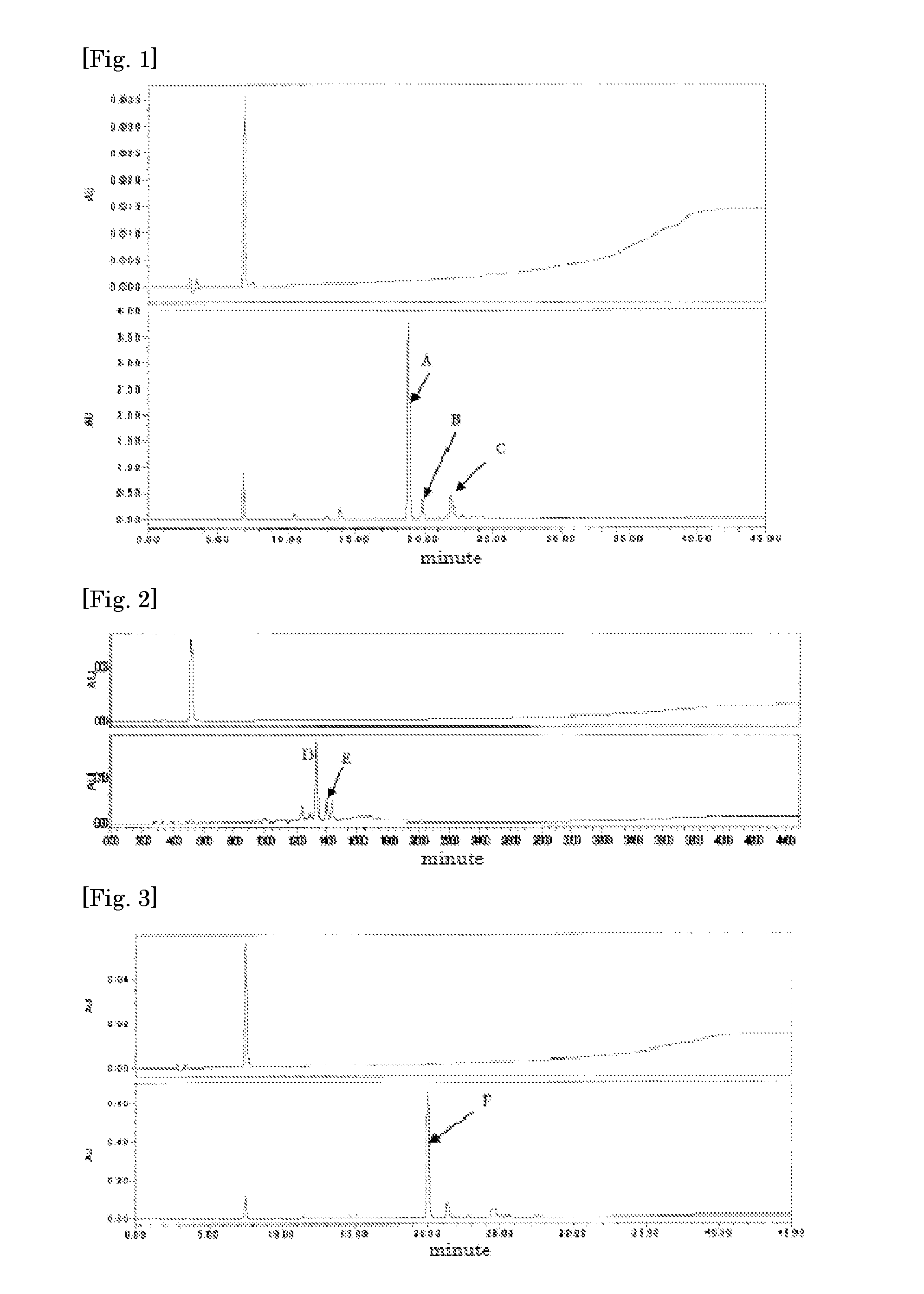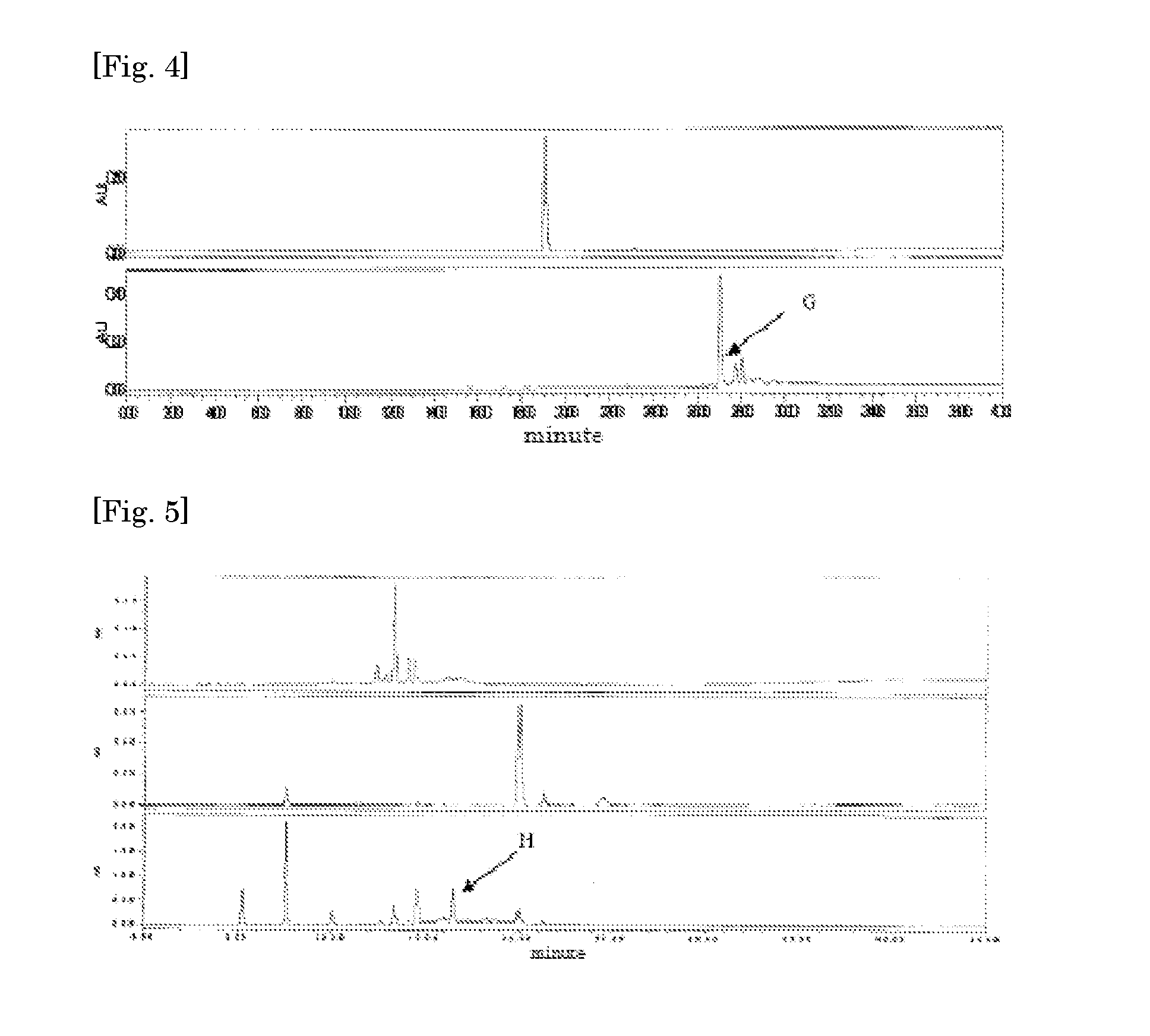Process for production of phenolic polymerizable compound having physiological activity
a technology of phenolic polymerizable compound and physiological activity, which is applied in the field of process for producing a phenolic polymerizable compound having physiological activity, can solve the problems of increasing cost and deterioration of working efficiency, complicated control of manufacturing conditions such as sealing and degassing, and serious problems such as workability, safety and the like for mass production, and achieves excellent physiological activity. , the effect of efficient and safe obtained
- Summary
- Abstract
- Description
- Claims
- Application Information
AI Technical Summary
Benefits of technology
Problems solved by technology
Method used
Image
Examples
example 1
Generation of Phenolic Polymerizable Compound from p-coumaric Acid
[0082]A mixed liquid (pH=7.5) obtained by dissolving 500 mg of p-coumaric acid (Wako Pure Chemical Industries, Ltd.) in 10 ml of ethanol, and then adding 10 ml of an aqueous 5% sodium hydrogencarbonate solution (Wako Pure Chemical Industries, Ltd.) was heated at 130° C. for 40 minutes in an autoclave (“SANYO LABO AUTOCLAVE” manufactured by SANYO Electric Co., Ltd., which was used in the following Examples). 1 ml of the obtained reactant was diluted with methanol in a measuring cylinder to 50 ml. Then, 10 μl of the resultant reactant was analyzed by HPLC.
[0083]The HPLC analysis was performed under the following conditions.
Column: Negative-phase column “Develosil (Registered Trademark) C-30-UG-5” (4.6 mmi.d.×250 mm)
Mobile phase: A . . . H2O (0.1% trifluoroacetic acid (TFA)), B . . . Acetonitrile (0.1% TFA)
Flow velocity: 1 ml / min
Pouring: 10 μl
Detection: 254 nm
[0084]Gradient (% by capacity): From 80% A / 20% B to 20% A / 80% ...
example 2
Isolation and Structural Determination of Phenolic Polymerizable Compound
[0086]The compounds contained in the peaks shown by A, B, and C of FIG. 1 in the reactants obtained in Example 1 were isolated by fractionation HPLC. When the isolated HPLC eluate was dried according to a usual method, 115 mg of a yellow powdery phenolic polymerizable compound (hereinafter referred to as UHA7009) was obtained from A. 15 mg of a yellow powdery phenolic polymerizable compound (hereinafter referred to as UHA7010) was obtained from B. 32 mg of a yellow powdery phenolic polymerizable compound (hereinafter referred to as UHA7011) was obtained from C.
[0087]Subsequently, when the molecular weight of each of the UHA7009, the 7010, and the 7011 was measured using a high resolution electron ionization-mass spectrometry (hereinafter referred to as EI-MS), the measured values were UHA7009: 240.2973, UHA7010: 360.4455, and UHA7011: 360.4458. The following molecular formulae were obtained from the comparison ...
example 3
Examination of Metal Salt to Generation Amount of Phenolic Polymerizable Compound
[0095]In order to examine metal salts capable of efficiently generating the three kinds of the phenolic polymerizable compounds, 50 mg of p-coumaric acid, 1 ml of ethanol, 1 ml of deionized water (1 ml of mineral water in the case of mineral water containing metal salt), and 50 mg of metal salt were added, and then heated at 130° C. for 30 minutes in an autoclave. All of the UHA7009, the UHA7010, and the UHA7011 were confirmed in the obtained reactants. The amount (% by weight) of the UHA7009 whose generation amount was the highest is shown in Table 5. Only the deionized water is the control. The metal salts used were sodium hydrogencarbonate, sodium carbonate, sodium hydroxide, sodium dihydrogenphosphate, sodium chloride, calcium chloride, calcium phosphate, calcium lactate, calcium carbonate, potassium hydroxide, potassium chloride, potassium dihydrogenphosphate, magnesium phosphate, magnesium chlorid...
PUM
| Property | Measurement | Unit |
|---|---|---|
| melting point | aaaaa | aaaaa |
| melting point | aaaaa | aaaaa |
| temperature | aaaaa | aaaaa |
Abstract
Description
Claims
Application Information
 Login to View More
Login to View More - R&D
- Intellectual Property
- Life Sciences
- Materials
- Tech Scout
- Unparalleled Data Quality
- Higher Quality Content
- 60% Fewer Hallucinations
Browse by: Latest US Patents, China's latest patents, Technical Efficacy Thesaurus, Application Domain, Technology Topic, Popular Technical Reports.
© 2025 PatSnap. All rights reserved.Legal|Privacy policy|Modern Slavery Act Transparency Statement|Sitemap|About US| Contact US: help@patsnap.com



